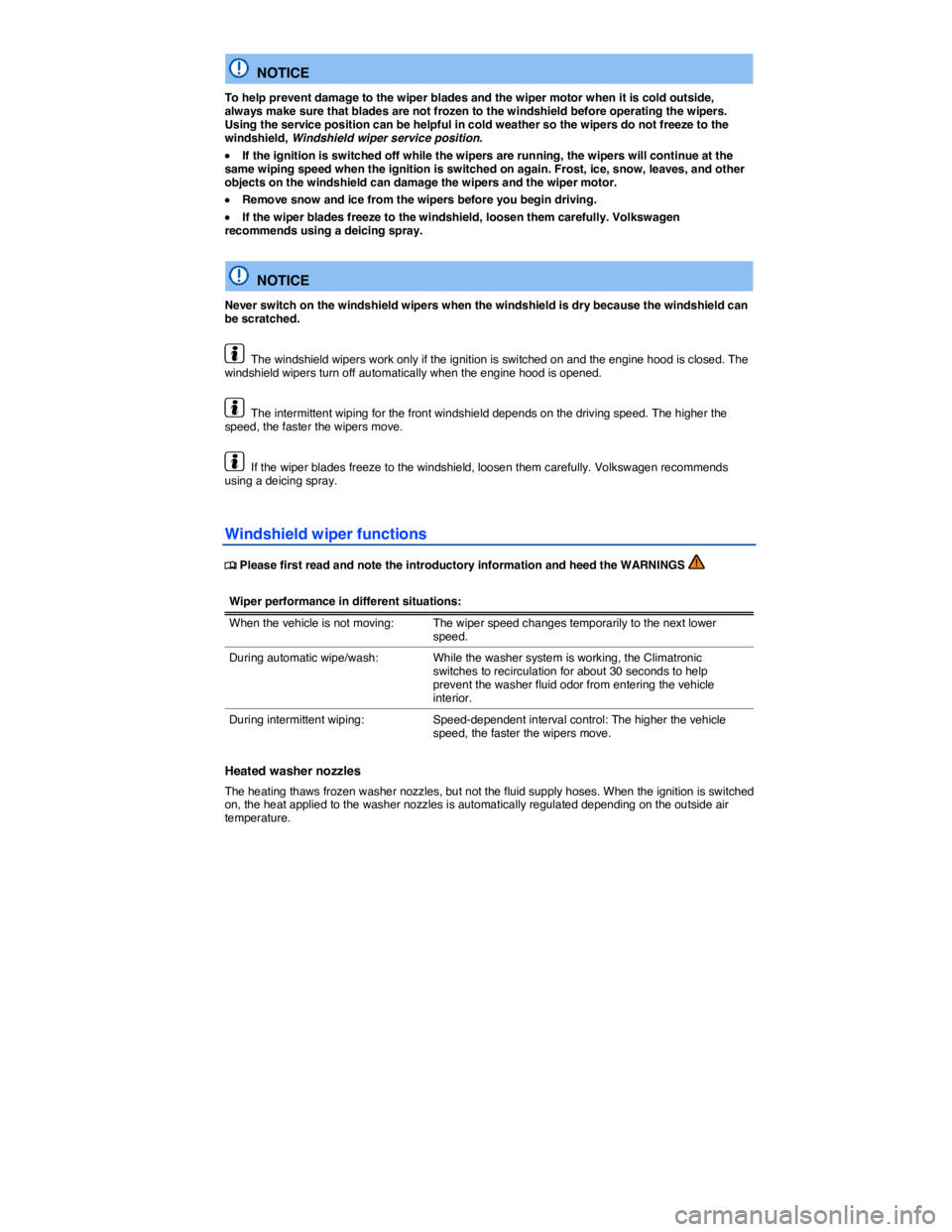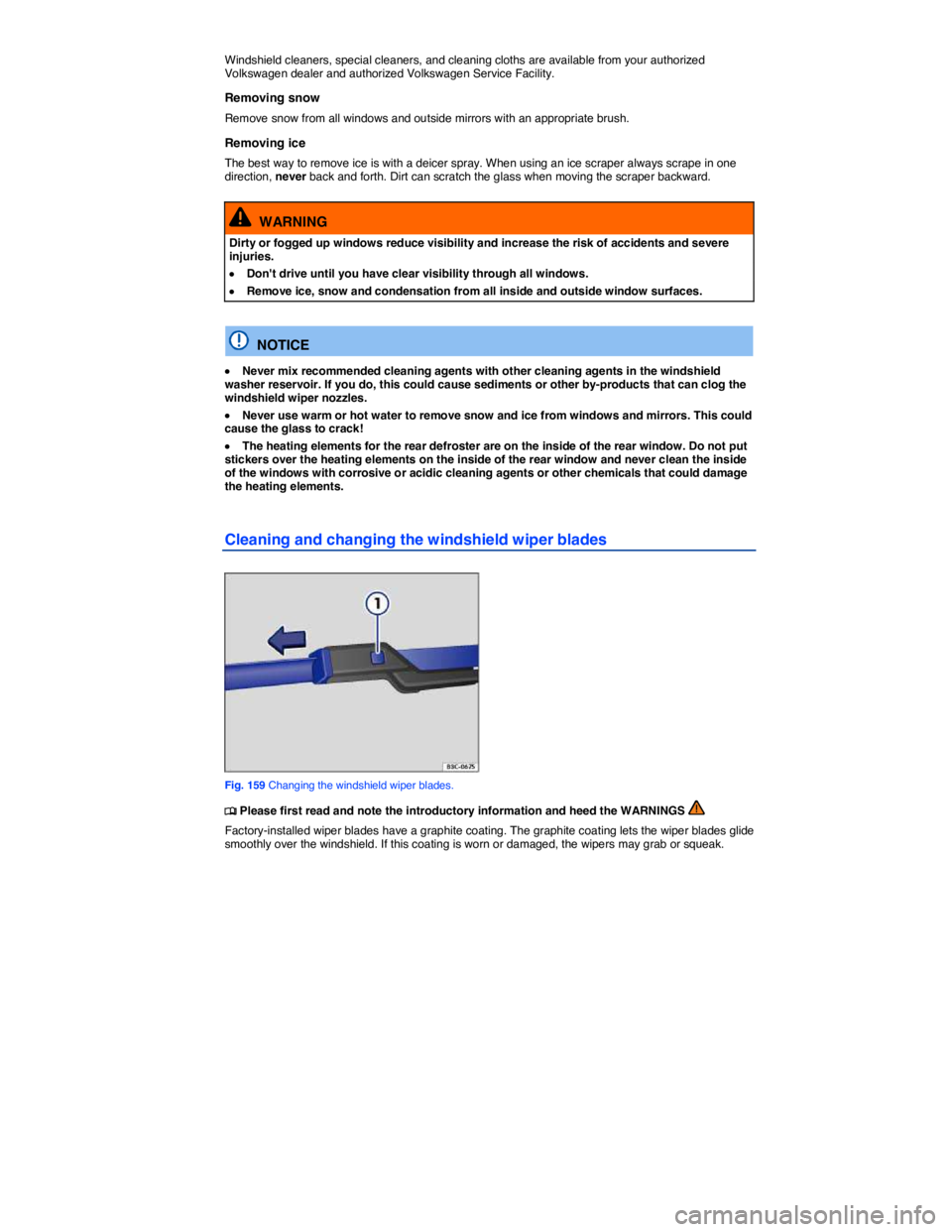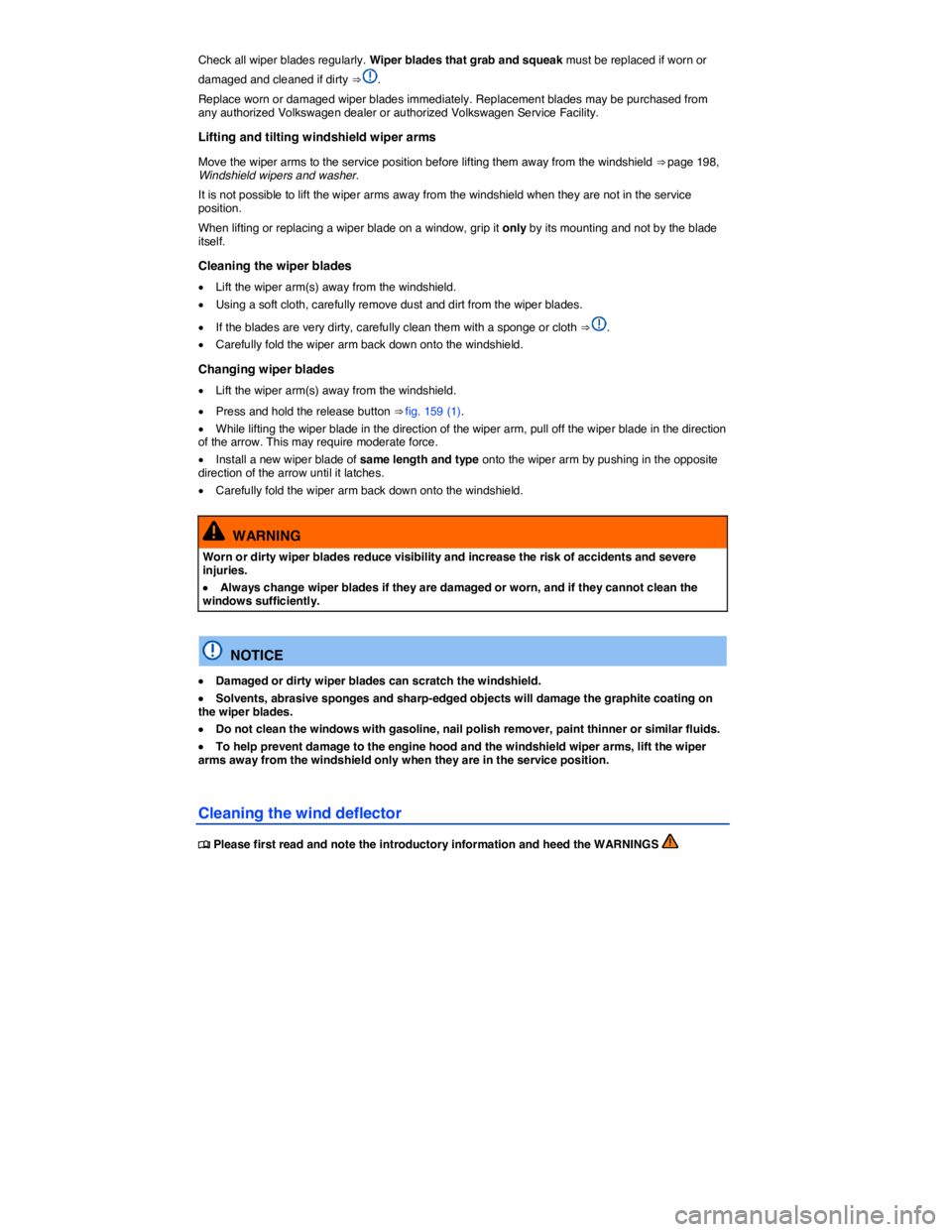2010 VOLKSWAGEN EOS wiper blades
[x] Cancel search: wiper bladesPage 118 of 381

NOTICE
To help prevent damage to the wiper blades and the wiper motor when it is cold outside, always make sure that blades are not frozen to the windshield before operating the wipers. Using the service position can be helpful in cold weather so the wipers do not freeze to the windshield, Windshield wiper service position.
�x If the ignition is switched off while the wipers are running, the wipers will continue at the same wiping speed when the ignition is switched on again. Frost, ice, snow, leaves, and other objects on the windshield can damage the wipers and the wiper motor.
�x Remove snow and ice from the wipers before you begin driving.
�x If the wiper blades freeze to the windshield, loosen them carefully. Volkswagen recommends using a deicing spray.
NOTICE
Never switch on the windshield wipers when the windshield is dry because the windshield can be scratched.
The windshield wipers work only if the ignition is switched on and the engine hood is closed. The windshield wipers turn off automatically when the engine hood is opened.
The intermittent wiping for the front windshield depends on the driving speed. The higher the speed, the faster the wipers move.
If the wiper blades freeze to the windshield, loosen them carefully. Volkswagen recommends using a deicing spray.
Windshield wiper functions
�
Page 121 of 381

Possible reasons for changes in the way the rain sensor works
The rain sensor may misread what is happening in the detection zone of its sensitive rain-sensor
surface ⇒ fig. 90 (arrow) and not work for a number of reasons, which include:
�x Worn out wiper blades: Worn out wiper blades may leave a film of water or wiping streaks; this can cause the wipers to run longer, to wipe more often, or to wipe continuously at high speed.
�x Insects: Insects hitting the sensor may trigger the wipers.
�x Salt streaks: Salt streaks on the windshield from winter driving can cause wiping more often or continuously on glass that is almost dry.
�x Dirt: Caked-on dust, wax, any other buildup on the windshield (lotus effect), or car-wash detergent residue can lower the rain sensor's sensitivity and cause it to react too slowly or not at all.
�x Crack or chip in the windshield: If a stone hits and chips the windshield while the rain sensor is on, this will trigger a wiper cycle. After that, the rain sensor will recognize the change and recalibrate itself to respond to the sensitive surface's reduced detection zone. Depending on the size of the chip, the sensor's reaction pattern may or may not change.
WARNING
The rain sensor cannot always recognize rain and activate the wipers.
�x Switch the wipers on manually when water on the windshield reduces visibility.
Clean the rain sensor's sensitive surface (arrow) regularly and check the wiper blades for wear or damage.
To remove wax and coats of polish safely, we recommend using an alcohol-based windshield cleaner.
Checking and refilling windshield washer fluid
Fig. 91 In the engine compartment: Cap of the windshield washer fluid reservoir.
�
Page 294 of 381

�x Never clean headlights with a dry cloth or sponge. Always use a wet cloth or sponge. For best results use soapy water.
�x When washing or rinsing the vehicle in cold weather, do not let water get into the lock cylinders or point the hose at gaps around the doors, hood, or luggage compartment lid. The water could freeze on the locks and seals and make it difficult to open the vehicle!
�x In cold weather, dry the rubber gaskets (rubber seals) and the surfaces they touch with a cloth to make sure they do not freeze shut.
NOTICE
To help prevent vehicle damage in a car wash:
�x Close the CSC roof completely.
�x Compare the vehicle track width with the dimensions of the guide rails in the car wash to help prevent damage to wheel rims and tires!
�x Switch off the rain sensor before driving the vehicle through a car wash, Rain sensor.
�x Make sure there is enough clearance for the height and width of the vehicle.
�x To help prevent paint damage to the engine hood, place wiper blades against the windshield after they have dried. Do not let them snap back into place.
�x Fold the outside mirrors toward the vehicle body. Do not fold power folding mirrors manually!
�x Lock the luggage compartment lid to help prevent unintentional opening in the car wash.
Washing with a power washer
�
Page 296 of 381

Windshield cleaners, special cleaners, and cleaning cloths are available from your authorized Volkswagen dealer and authorized Volkswagen Service Facility.
Removing snow
Remove snow from all windows and outside mirrors with an appropriate brush.
Removing ice
The best way to remove ice is with a deicer spray. When using an ice scraper always scrape in one direction, never back and forth. Dirt can scratch the glass when moving the scraper backward.
WARNING
Dirty or fogged up windows reduce visibility and increase the risk of accidents and severe injuries.
�x Don't drive until you have clear visibility through all windows.
�x Remove ice, snow and condensation from all inside and outside window surfaces.
NOTICE
�x Never mix recommended cleaning agents with other cleaning agents in the windshield washer reservoir. If you do, this could cause sediments or other by-products that can clog the windshield wiper nozzles.
�x Never use warm or hot water to remove snow and ice from windows and mirrors. This could cause the glass to crack!
�x The heating elements for the rear defroster are on the inside of the rear window. Do not put stickers over the heating elements on the inside of the rear window and never clean the inside of the windows with corrosive or acidic cleaning agents or other chemicals that could damage the heating elements.
Cleaning and changing the windshield wiper blades
Fig. 159 Changing the windshield wiper blades.
�
Page 297 of 381

Check all wiper blades regularly. Wiper blades that grab and squeak must be replaced if worn or
damaged and cleaned if dirty ⇒ .
Replace worn or damaged wiper blades immediately. Replacement blades may be purchased from any authorized Volkswagen dealer or authorized Volkswagen Service Facility.
Lifting and tilting windshield wiper arms
Move the wiper arms to the service position before lifting them away from the windshield ⇒ page 198, Windshield wipers and washer.
It is not possible to lift the wiper arms away from the windshield when they are not in the service position.
When lifting or replacing a wiper blade on a window, grip it only by its mounting and not by the blade itself.
Cleaning the wiper blades
�x Lift the wiper arm(s) away from the windshield.
�x Using a soft cloth, carefully remove dust and dirt from the wiper blades.
�x If the blades are very dirty, carefully clean them with a sponge or cloth ⇒ .
�x Carefully fold the wiper arm back down onto the windshield.
Changing wiper blades
�x Lift the wiper arm(s) away from the windshield.
�x Press and hold the release button ⇒ fig. 159 (1).
�x While lifting the wiper blade in the direction of the wiper arm, pull off the wiper blade in the direction of the arrow. This may require moderate force.
�x Install a new wiper blade of same length and type onto the wiper arm by pushing in the opposite direction of the arrow until it latches.
�x Carefully fold the wiper arm back down onto the windshield.
WARNING
Worn or dirty wiper blades reduce visibility and increase the risk of accidents and severe injuries.
�x Always change wiper blades if they are damaged or worn, and if they cannot clean the windows sufficiently.
NOTICE
�x Damaged or dirty wiper blades can scratch the windshield.
�x Solvents, abrasive sponges and sharp-edged objects will damage the graphite coating on the wiper blades.
�x Do not clean the windows with gasoline, nail polish remover, paint thinner or similar fluids.
�x To help prevent damage to the engine hood and the windshield wiper arms, lift the wiper arms away from the windshield only when they are in the service position.
Cleaning the wind deflector
�